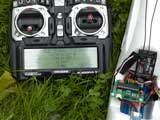Among others, one thing that makes the 2.4GHz Aurora 9 so great is the big LCD in combination with the full telemetry features of the Optima 7/9 receivers. These receivers contain a so-called data port that connects to Hitec’s sensor station. Sensor stations come in 2 flavors: a nitro version for gas and glow powered planes and a blue version for electric powered aircrafts.
But … Hitec’s sensor stations are not so versatile as they should be, therefore I developed one by myself. It works so great that I decided to share my design and introduce a DIY kit. Also great is that all software and hardware is open source. Build one by yourself or buy a DIY kit containing all necessary components and a professionally manufactured circuit board.
DIY sensor station in short
Features
- Design is and will be open source meaning you can update / modify hardware and firmware to your own needs.
- Emulates ALL the messages of the nitro AND blue sensor stations in a flexible way. E.g. you can monitor a voltage and display it in the ‘fuel gauge’ icon on the A9 screen (or both!)
- Powered by standard ESC / receiver ACCU (<5.5V)
- Based on ATmega8L microcontroller, firmware upgradeable (the programming connector is on board, you build a $3 programmer yourself of buy one from eBay)
- GPS connector to interface a MediaTek 10Hz GPS available at diydrones. These are cheap, fast lock and small enough to build in any plane. On the PCB the GPS receive and transmit signals are accessible to connect another GPS signal. The default firmware decodes the NMEA RMC en GGA messages)
- 2 analog inputs to monitor voltages, range is selected by a resistor. Lipo battery can be monitored directly. See application ideas to interface a temperature sensor.
- 4 inputs to the ATMega to interface custom circuitry. E.g. counting pulses for RPM measurements.
- 1 input for a current sensor. Basicly this is a voltage sensing input that is optimized to interface the easy to use and cheap ACS756 device. See the section application ideas. Sparkfun also sells high current sensors that are easily interfaces.
- Board size approx: 2.1’ x 1.5’ (54mm * 31mm)
- Red status LED. Blinks at powerup and flashes during measurements.
- 3.3V data interface to the receiver (as in genuine sensorstations)
- The DIY kit contains all components and a professional manufactured PCB for easy soldering.
- The DIY kit contains only a few necessary SMD components. All other components are ‘through hole’ so you don’t have to be a jedi to build your own. Only basic soldering skills and a small soldertip are required. Creating your sensor station will last only a few hours. See the detailed building guide for more info.
- Compatible with Aurora 9 firmware 1.08 (and feature updates)
- DIY kit comes with a preprogrammed ATMega8L microcontroller









